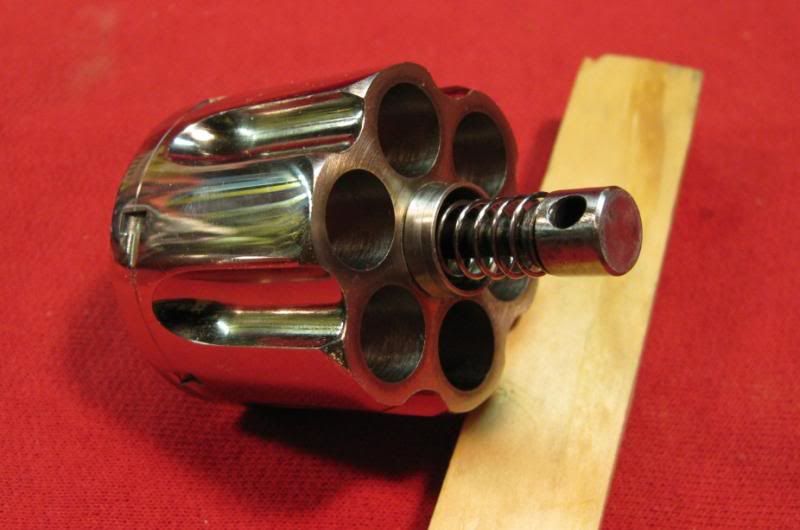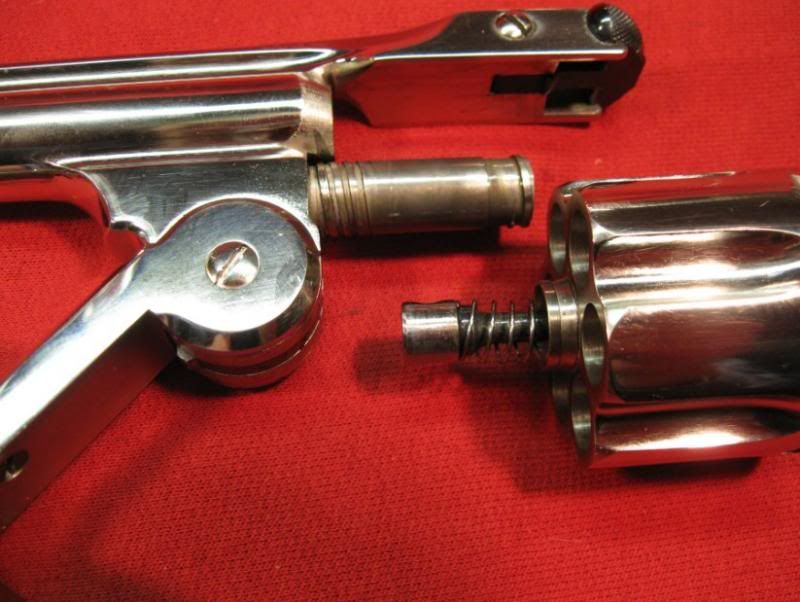Howdy
First of all, some definitions.
#3 denotes frame size with the old S&W Top Breaks, not a specific model. Just like K frame today denotes the mid frame size, but does not define a specific model. The #3 size frame was the largest Top Break frame that S&W made and most of the models built of that size were either 44 or 45 caliber, although there were also smaller chamberings too on the large frame.
There were five specific models of Top Breaks built on the #3 frame. In order of their appearance, there was the American Model, the Russian Model, the Schofield, the New Model Number Three, and the 44 Double Action.
This is the American Model. First produced in 1870, this was the first Top Break of any sort that S&W made. It was chambered for the obsolete 44 American cartridge, which utilized a heeled bullet. A few were also chambered for the 44 Henry Rimfire cartridge. As an identification feature, notice how straight 'up and down' the grip is.
There has never been a modern reproduction made of this model.
Next came the Russian Model. S&W produced many thousands of these, mostly for sale to the Russian government, also to Turkey and Japan. And some were sold domestically too. Easily recognized by the extra large hump on the grip (S&W calls this a 'knuckle'), as well as the spur on the trigger guard. Some shooters sawed the spur off because it served no practical purpose. Mostly chambered for the 44 Russian cartridge, which the Russians stipulated have a bullet that fit inside the case, rather than a heeled bullet. A few were also chambered for 44 Henry Rimfire.
This one is a 2nd Model Russian, made in 1875.
Uberti makes a reasonable copy of the Russian model, chambered for 45 Colt, 44-40, 44 Russian and 38 Special.
I will caution you, that sharp point on the grip can be painful with a heavy recoiling cartridge if you don't keep it up above your hand. This one is chambered for 44 Russian, a very mild cartridge for such a big gun. But because of the reach to the hammer spur, I have to regrip to cock the hammer, then regrip again to get my palm below the spur. If I do not regrip, and fire the gun so that the point strikes my palm, it hurts.

This is the Schofield Model. Similar in appearance to the American Model, but the grip is shaped slightly differently, not quite as vertical. The other difference is, the Schofield was the only large Top Break that S&W made with the barrel latch mounted on the frame, not the top of the barrel extension like all the others. You can see the serpentine shaped latch in front of the hammer. S&W produced the Schofield to compete with the Colt Single Action Army for military contracts. There were only about 8,000 produced, all were chambered for the 45 Schofield cartridge, a 45 caliber round slightly shorter than the 45 Colt round.
This is a First Model Schofield, also made in 1875. It is more forgiving to shoot than the Russian Model because of the grip shape.
Uberti makes a nice replica of the Schofield model, chambered for 45 Colt, 44-40, 44 Russian and 38 Special. Avoid the ASM Schofields, they had problems.
This is the New Model Number Three. This was the epitome of large frame S&W Top Break design. The small knuckle on the grip serves to keep the hand in place on the grip during recoil, much like the knuckle does on a modern S&W revolver. I find that I have to regrip slightly with all my #3 Smiths because of the distance to the hammer spur and the way the spur always points straight up. But the New Model Number Three is the most comfortable to shoot.
This one was made in 1882, and refinished at the factory in 1965, that is why it looks so good. It is chambered for 44 Russian, the most common chambering of the New Model Number Three. The New Model Number Three was also chambered for many other cartridges. Records were made by target shooters shooting the New Model Number Three that have never been broken.
Beretta markets a replica of the New Model Number Three they call the Laramie. It is actually manufactured by Uberti, a subsidiary of Beretta. I do not know if the Laramie is currently being produced, but there are some available on the used market. All the Laramie revolvers have an adjustable rear sight, not a standard feature on the originals. I believe it is/was chambered for 45 Colt and 38 Special.
The last of the five Top Break revolvers built on the #3 sized frame was the 44 Double Action. This one is a target model, made in 1895. It is chambered for the 44 Russian cartridge, the most common chambering of the model. This model was also chambered for many other cartridges.
There have never been any modern replicas made of the 44 Double Action.
***
So much for the history of the #3 sized Top Breaks. All of the replicas being made today in Italy are proofed in Government run proof houses. European proofing standards are actually slightly stricter than American standards, and all of the modern replicas can be safely fired with SAAMI spec ammunition. They do not have to be restricted to 'cowboy' ammunition. By the same token, they should not be fired with 'Ruger Only' loads, or any of the hot self defense loads. SAAMI MAX spec only.
Regarding them shooting loose, with the originals, absolutely. The iron (not always steel, often iron) frames of the originals could easily be shot loose with Smokeless ammo, even mild loads. I have another 44 Double Action that was shot loose when I bought it, but an expert gunsmith was able to tighten it up. I NEVER shoot Smokeless ammo in my antiques, only Black Powder.
While the replicas are made of modern steel, they probably will shoot loose over time if subjected to the pounding of a lot of heavy recoil. On the other hand, I know several cowboy shooters who have shot their Schofield reproductions for years with no problems. I suspect they are only shooting 'cowboy' ammo but I do not know that for sure.
A couple more things. Although the replicas are chambered for 45 Colt, S&W NEVER chambered any of their Top Breaks for that cartridge, including the Schofields that were made around the year 2000.
Lastly, because of design changes related to lengthening the cylinders to accept cartridges the length of 45 Colt and 44-40, the modern replicas do not do well with Black Powder, tending to bind up rather quickly from fouling deposited on the cylinder arbor. The originals were designed for Black Powder and can shoot it all day long.














